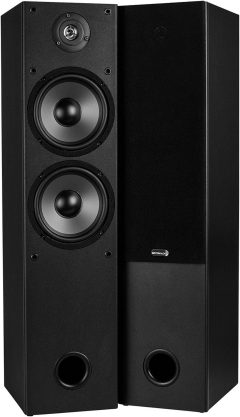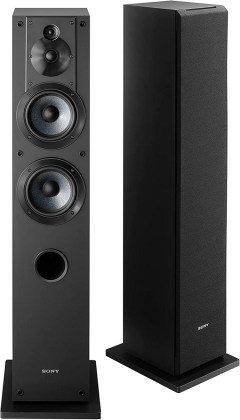Buying guide for Best floorstanding speakers
Is it time to upgrade your sound system with some floorstanding speakers? They produce a great sound, are elegant and sleek, and once in place, you’ll wonder how you ever enjoyed music or movies without them.
These speakers are a substantial investment, though, so you need to take your time and make sure you’re getting what you want. Where will you put them? Are you using them just for music or attaching them to your television? How big or small is the room where you’ll be using them? These are some of the nontechnical but essential questions to consider before opening your wallet.
Key considerations
Size
Footprint: Floorstanding speakers are tall and thin. Most of them have a footprint of no more than a square foot. Although there are a few that are 17 x 17 inches or so, these are the exception rather than the rule. What all this means is that these speakers don’t occupy much floor space, which is good.
Height: The main concern with these speakers is the height. Most of them are between 3 and 3.5 feet tall. Considering that most dining room tables average about 30 inches tall, that means these speakers can tower above the top of a table by as much as a foot. These speakers are often referred to as “tower” speakers, and you can see why.
Tall, narrow objects are notoriously unstable and easy to tip over. If you’ve never owned floorstanding speakers, be aware that positioning them will be dictated by more than just the way they sound. Think about where you’re going to put the speakers so they’re not obstructing bookcases, foot traffic, or views out the window.
Number
Closely related to and influenced by size is the number of speakers you need. A single speaker by itself will produce an unbalanced sound from your stereo or TV. The minimum you need is two. If you want a surround sound system of speakers, you’re going to need at least four and possibly more. Remember that these are large speakers that are easy to knock over. The more of them you have, the closer attention you need to pay to their position.
Positioning
All of these points are closely interrelated, so much so that it’s difficult to know where one ends and the other begins, but positioning depends as much on the size and number of speakers as on the quality of the sound. Take a close look at the room where you’ll be putting the speakers and try to envision what it will look like with them there. Stack up some empty boxes to simulate the speakers in the room.
Balanced sound: If your stereo or TV sits on a built-in shelf or cabinet, the speakers won’t be able to stand flush with the front of it and instead will be out front where there is the potential to interfere with people walking around the room. To avoid that, you’ll need to move the speakers farther to the sides. The farther you move them, the more you’ll have to experiment with the sound to make sure it’s balanced and the voices or music don’t all seem to be coming from one side of the room.
Focused sound: Avoiding the balance problem creates a focus problem, where the optimal sound — the sweet spot — is located in one small section of the room. Only the person sitting in that spot hears everything perfectly. Finding the correct balance will be different for every situation because no two rooms are the same.
Sound absorption: Hardwood floors, bare glass windows, and non-upholstered furniture will cause more reverberation than a room with carpet or rugs on the floors, drapes over the windows, and upholstered furniture. However, a carpeted room with a lot of cushioned furniture and floor-to-ceiling drapes could absorb so much sound that you might have to crank the volume all the way up to hear anything.
Did You Know?
The name “tweeter” comes from the high-pitched tweeting sounds made by songbirds. “Woofers” were named after the low-pitched sounds made by large dogs.
Staff
BestReviews
Features
Materials
Cabinet: Many speaker cabinets are made from plastic with a black or wood-grain finish. Some are made of wood.
Grille: The speaker grilles are usually a soft cotton or nylon fabric.
The drivers (the individual speakers) are made from a variety of materials:
Cone: The cone or diaphragm is typically made from paper, thin plastic, or injection-molded graphite. The wide end is attached to the suspension.
Suspension: This is a rim of flexible material, such as rubber or soft plastic. It attaches to the basket.
Basket: The basket, the driver’s frame, is usually made from metal. Aluminum is common.
Voice coil: The voice coil at the narrow end of the basket is usually made of copper with some magnets.
Drivers
Tweeters: The tweeters are small drivers that produce sounds in the range of 2,000 to 20,000 hertz (Hz). Note that 20,000 Hz is the highest-pitched sound the human ear can detect. On an 88-key piano, middle C is 261.6 Hz, while the highest key on the keyboard, a C, is 4,186 Hz. You would hear the upper two octaves on the keyboard through the tweeter.
Woofers: Woofers are physically larger than tweeters because low-pitched sounds are slower than high-pitched ones and require a larger diaphragm to produce. Woofers typically produce sound in the 20 to 500 Hz range. On a piano, the lowest key is an A at 27.5 Hz. You would hear the bottom four octaves on the piano through a speaker’s woofers.
Mid-range: The mid-range drivers take care of the frequencies between the woofers and tweeters. In most floorstanding speakers, the mid-range drivers and woofers look very similar.
Bass-reflex speakers are more efficient than acoustic suspension (sealed enclosure) speakers, but the sound quality isn’t as precise.
Staff
BestReviews
Accessories
Speaker feet: Zerone Speaker Spike Pad Kit
When you’ve got too much vibration under your speakers, these spikes from Zerone can decouple the speaker from the floor to eliminate that vibration and noticeably improve the sound quality.
Speaker cables: Mediabridge Ultra Series Speaker Cables
When you need new, or longer, speaker cables Mediabridge has them from 3 to 25 feet long, with corrosion-resistant gold-plated banana tips.
Did You Know?
A three-way speaker has three drivers inside it: tweeter, midrange, and woofer. A two-way speaker only has a tweeter and a woofer.
Staff
BestReviews
Floorstanding speaker prices
Inexpensive
Under $100 is the low price range for floorstanding speakers. Many of them are Bluetooth speakers meant to be used wirelessly with your smartphone or mobile device rather than with a stereo or HD television system.
Mid-range
The medium price range is $100 to $200 for a single floorstanding speaker. Most of these have at least one tweeter and two woofers. The woofers are usually bass-reflex speakers that provide more sound than acoustic-suspension woofers. You’ll find some wooden cabinets in this price range.
Expensive
Speakers that cost over $200 may have active crossover designs instead of passive ones, high-quality bases, and feet to eliminate floor vibration, aluminum woofers, and advanced tweeters.
Tips
- Watch out for vibration. Speakers that are set flush on the floor may create audible vibrations that can interfere with the quality of the sound.
- Keep your speakers clean. The best way to clean a tweeter is with canned air. Hold the tip of the nozzle about 12 to 18 inches away from the tweeter and give it short, controlled blasts. The best way to clean a woofer cone is with a dry microfiber cloth. The cabinet of a floorstanding speaker can be cleaned with furniture polish.
FAQ
Q. What does “toe-in” mean?
A. Toe-in refers to the angle of the speaker relative to you. A speaker that is turned to your left (toe-in) sounds warm and rich. A speaker that is turned to the right (toe-out) sounds more defined and detailed.
Q. What is a crossover?
A. Crossover is the name of a unit inside the speaker that separates the high and low frequencies coming from the amplifier. It sends the divided frequencies to the tweeter or woofer.
Q. Are floorstanding speakers better than dedicated woofer and tweeter speakers?
A. That’s a philosophical question dictated by individual taste. If floorstanding speakers are the cat’s meow for you, don’t be dissuaded by anyone. Stick to your guns and get what you like.

























